 IST,
IST,
IV. Price Situation
Headline inflation, which had edged up sharply in a number of economies during September 2005 on account of international crude oil prices reaching record highs in August 2005, eased marginally during the fourth quarter of 2005 in tandem with some moderation in crude oil prices. Notwithstanding the recent easing, headline inflation remains at elevated levels - above the targets in case of many central banks. The impact of higher oil prices on economic activity and inflation expectations seems to have been largely contained reflecting a variety of factors such as increased competition due to globalisation, fall in intensity of oil usage in advanced economies, continuous pre-emptive monetary tightening through measured increases in policy rates and, in case of many emerging market economies, less-than-complete pass-through. Nonetheless, as a significant part of the increase in international crude oil prices is increasingly viewed as somewhat permanent, the outlook for inflation remains uncertain in view of possible second-round effects.
In India, headline inflation and inflation expectations remained well-contained during the quarter ended December 2005, despite continued dominance of supply-side factors. Fiscal and monetary measures undertaken since mid-2004 to reduce the impact of imported price pressures on domestic inflation and to stabilise inflationary expectations have been successful in containing inflation towards the desired trajectory during the financial year so far.
Global Inflation
In the US, consumer price inflation, which had accelerated from 2.5 per cent in June 2005 to 4.7 per cent by September 2005 due to sharp increase in energy costs, eased to 3.4 per cent by December 2005. Core inflation (i.e., excluding food and energy prices), on the other hand, at around 2.0 per cent has been broadly unchanged since early 2005 although there are concerns that elevated energy prices could put pressure on core inflation (Chart 25). Reflecting the strong economic activity and the incipient inflationary pressures, the US Federal Reserve persevered with its measured pace of monetary tightening raising its target Federal Funds rate by a further 150 basis points over end-March 2005 (25 basis points hike at each of its six meetings) to take the Fed Funds rate to more neutral levels. According to the US Federal Open Market Committee (FOMC), although possible increases in resource utilisation and elevated energy prices have the potential to add to inflation pressures, longer-term inflation expectations in the US remain contained. The FOMC believes that some further measured policy firming is needed to keep the risks to the attainment of both sustainable growth and price stability roughly in balance.
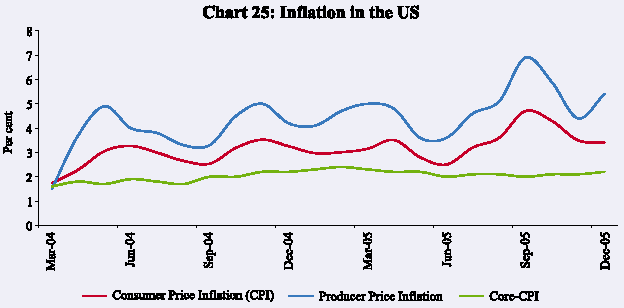
In the euro area too, inflation, measured by the Harmonised Index of Consumer Prices (HICP), eased - from the recent peak of 2.5 per cent in September 2005 - to 2.2 per cent in December 2005 but still exceeding the target of ‘below but close to 2.0 per cent’. Nonetheless, upside risks are seen by the European Central Bank (ECB) due to the potential second-round effects in wage and price setting behaviour from oil market developments and further increases in administered prices and indirect taxes. The ECB, therefore, raised the key policy rate by 25 basis points on December 1, 2005 - after maintaining rates at historically low levels for two and a half years - to keep medium to long-term inflation expectations in the euro-area anchored to levels consistent with price stability (Table 22). The ECB kept the key policy rates unchanged at its meeting held on January 12, 2006.
|
Table 22: Inflation Indicators – Developed Economies |
||||||||
|
(Per cent) |
||||||||
|
Country/ |
Key Policy |
Policy Rates |
Changes in |
2004 |
2005 (Latest) |
|||
|
Region |
Rate/Bank |
(January 18, |
Policy Rates in |
Inflation |
Growth |
Inflation |
Growth |
|
|
Reserve Target |
2006) |
basis points |
(y-o-y) |
(December) |
(y-o-y) |
|||
|
(since end- |
(Q3) |
|||||||
|
December 2004) |
||||||||
|
1 |
2 |
3 |
4 |
5 |
6 |
7 |
8 |
|
|
Australia |
Cash Rate |
5.50 |
25 |
2.3 |
3.2 |
3.0 * |
2.6 |
|
|
Canada |
Overnight Rate |
3.25 |
75 |
1.8 |
2.9 |
2.2 |
2.8 |
|
|
Euro area |
Interest Rate on Main |
|||||||
|
Refinancing Operations |
2.25 |
25 |
2.1 |
2.0 |
2.2 |
1.6 |
||
|
Japan |
Target Balance of |
30-35 |
Unchanged |
0.0 |
2.7 |
-0.8 # |
2.9 |
|
|
Current Account |
trillion yen |
|||||||
|
New Zealand |
Official Cash Rate |
7.25 |
75 |
2.3 |
4.8 |
3.4 * |
2.3 |
|
|
UK |
Repo Rate |
4.50 |
(-) 25 |
1.3 |
3.2 |
2.0 |
1.7 |
|
|
US |
Federal Funds Rate |
4.25 |
200 |
2.7 |
4.2 |
3.4 |
3.6 |
|
|
* : Q3. # : November. y-o-y : year-on-year. |
||||||||
In the UK, CPI inflation which had accelerated to 2.5 per cent in September 2005 – the highest rate since January 1997 – driven up by higher oil prices eased to 2.0 per cent in December 2005. The Bank of England, which had cut the policy repo rate by 25 basis points on August 4, 2005 in response to the weakening of economic activity, persevered with the policy stance although inflation is expected to remain above the target of 2.0 per cent in the near term.
In Japan, mild deflation continues despite economic recovery. Consumer prices, year-on-year, declined by 0.8 per cent in November 2005 as against an increase of 0.8 per cent a year ago (Chart 26). Core CPI, however, turned positive (0.1 per cent) for the first time after a gap of two years. With annual rate of change in consumer prices projected to turn slightly positive on the back of improving supply-demand conditions, the Bank of Japan (BoJ) persisted with the target range for bank reserves at 30-35 trillion yen set since January 2004 while allowing the balance of current accounts with it to fall short of the target in case of weak liquidity demand.
In China, consumer price inflation decelerated to 1.3 per cent in November 2005 from 4.0 per cent a year ago, due mainly to a decline in the prices of grains, clothing, communication services and some consumer durables (Chart 27). Amongst other Asian economies, inflation in Indonesia edged up sharply from 9.1 per cent in September 2005 to 17.1 per cent in December 2005, driven up by further increases in administered fuel prices and currency depreciation. With core inflation projected to be 9.5 per cent – above the medium-term inflation target of 6 (+/-1) per cent - the Bank Indonesia continued to tighten monetary policy. It has raised the policy rate by 275 basis points since end-September 2005 - 100 basis points hike on October 4, 2005, 125 basis points hike on November 1, 2005 and another 50 basis points hike on December 6, 2005 - to 12.75 cent. In the Philippines too, CPI inflation at 6.6 per cent in December 2005
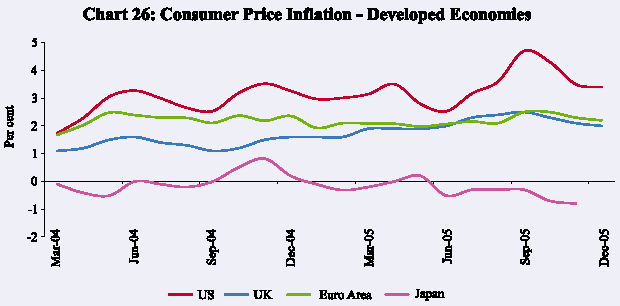
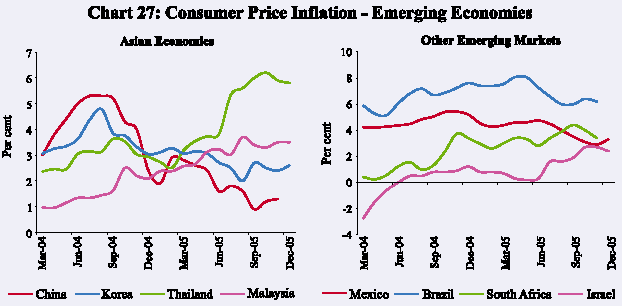
remained above the target of 5-6 per cent. With supply-side inflation pressures expected to build-up further over the policy horizon through the second-round effects of higher oil prices, the Bank of Philippines has raised the policy reverse repo rate further by 25 basis points in October 2005 to 7.5 per cent. However, with some easing of energy prices, a normal weather, the strengthening of peso and generally favourable demand-side pressures, the Bank of Philippines has since then left the key policy rates unchanged.
In Thailand, headline (6.2 per cent) inflation accelerated in October 2005 driven up by persistent increases in oil prices before easing somewhat to 5.8 per cent in December 2005. With growth momentum remaining strong and probability of core inflation exceeding the target range (0-3.5 per cent), the Bank of Thailand has raised policy interest rates further by 100 basis points since end-September 2005 - 50 basis points on October 19, 2005 and 25 basis points each on December 14, 2005 and January 18, 2006 - to 4.25 per cent (Table 23). In Korea, inflation moderated somewhat from 2.7 per cent in September 2005 to 2.6 per cent in December 2005 (3.0 per cent a year ago). Nonetheless, latent inflationary pressures are seen due to strong economic recovery and the persistently high oil prices. The Bank of Korea has accordingly raised the policy rate by 50 basis points since end-September 2005 - 25 basis points each on October 11, 2005 and December 8, 2005 - to 3.75 per cent.
To conclude, inflation pressures which had increased in the third quarter of calendar year 2005, moderated somewhat in a number of economies in the fourth quarter with some easing in energy prices. Notwithstanding this moderation, inflation remains at elevated levels in most of the economies. Although the second round effects of recent oil prices hikes have been muted so far and core inflation remains low, the prospect of a higher second round pass-through has prompted
|
Table 23: Inflation Indicators – Developing Economies |
||||||||
|
(Per cent) |
||||||||
|
Country/ |
Key Policy |
Policy Rates |
Changes in |
2004 |
2005 (Latest) |
|||
|
Region |
Rate/Bank |
(January 18, |
Policy Rates in |
Inflation |
Growth |
Inflation |
Growth |
|
|
Reserve Target |
2006) |
basis points |
(y-o-y) (December) |
(y-o-y) |
||||
|
(since end- |
(Q3) |
|||||||
|
December |
||||||||
|
2004) |
||||||||
|
1 |
2 |
3 |
4 |
5 |
6 |
7 |
8 |
|
|
Brazil |
Selic Rate |
17.25 |
(-) 50 @ |
6.6 |
4.9 |
6.2^ |
1.0 |
|
|
China |
M2 |
— |
— |
3.9 |
9.5 |
1.3^ |
9.4 |
|
|
India |
Reverse Repo Rate |
5.25 |
50 |
3.8 |
6.9 * |
5.3^ |
8.1 |
|
|
Israel |
Key Rate |
4.50 |
60 |
(-) 0.4 |
4.4 |
2.4 |
5.7 |
|
|
Korea |
Overnight Call Rate |
3.75 |
50 |
3.6 |
4.6 |
2.6 |
4.5 |
|
|
Philippines |
Reverse Repo Rate |
7.50 |
75 |
6.0 |
6.0 |
6.6 |
4.1 |
|
|
South Africa |
Repo Rate |
7.00 |
(-) 50 |
1.4 |
3.7 |
3.4^ |
4.9 |
|
|
Thailand |
14-day Repo Rate |
4.25 |
225 |
2.7 |
6.1 |
5.8 |
5.3 |
|
|
* : Fiscal year 2004-05. |
||||||||
a number of central banks to tighten monetary policy during the recent months in order to contain inflation and inflationary expectations.
Global Commodity Prices
After recording continuous upward movements to record highs in August 2005, international crude oil prices moderated somewhat during November-December 2005 but again increased during January 2006 (Chart 28). Non-fuel commodity prices edged higher during the quarter ended December 2005 due to increases in metals prices.
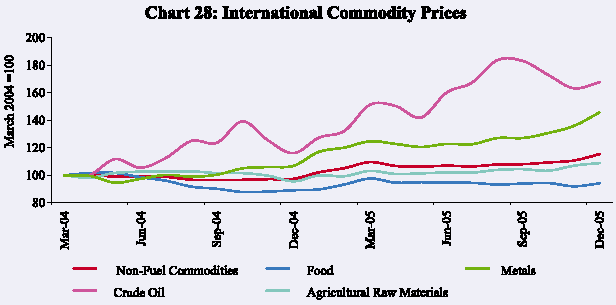
Strong growth in global demand, economic resilience to higher energy costs, supply concerns due to hurricane-related disruptions in the US (hurricanes Katrina and Rita during August-September 2005) and a three decade low global oil spare capacity supported oil prices during 2005 despite periodic increases in supply by the Organisation of the Petroleum Exporting Countries (OPEC). Besides fundamentals, concerns over stability of supplies from the Middle East due to geo-political uncertainties as well as speculative purchases by hedge funds further added to nervousness in the world oil market imparting a great deal of volatility to oil prices. Reflecting these factors, international crude oil prices reached successive record highs during 2005 - the US West Texas Intermediate (WTI) crude prices rose to an all-time peak of US $ 70.8 a barrel on August 30, 2005 in the immediate aftermath of Hurricane Katrina. Prices then moderated to below US $ 60 a barrel during November-December 2005 due to a variety of factors: concerted efforts by the International Energy Agency (IEA) to release emergency stocks of 2 million barrels a day (mb/d) of crude and products to compensate for the outage in the US Gulf Coast due to the Hurricane Katrina; OPEC’s decision to make available existing spare capacity in member countries of around 2 mb/d for a three-month period in its Vienna meeting during September 19-20, 2005; firmer signs of slowing global demand growth; significant recovery from hurricane damages to oil production in the Gulf of Mexico; and relatively warmer weather during October-November 2005. Notwithstanding this moderation, international crude oil prices have surged by about 67 per cent from US $ 33.7 per barrel in March 2004 to US $ 56.4 per barrel in December 2005 (Table 24). Prices, however, again edged higher to reach US $ 67 a barrel on January 18, 2006 on reports of a decline in US crude stocks, disruption of Russian natural gas deliveries to Ukraine threatening supplies to Western Europe, tensions over Iran’s nuclear programme and unrest in Nigeria.
With limited spare global crude oil production capacity and the U.S. oil production and refining industries still to recover fully, oil prices are likely to react sharply to any additional disruption of or damage to petroleum infrastructure (Table 25). Accordingly, oil prices are expected to remain firm in the near future.
|
Table 24: International Crude Oil Prices |
||||||||
|
(US dollars per barrel) |
||||||||
|
Item |
2002- |
2003- |
2004- |
March |
June |
September |
November |
December |
|
03 |
04 |
05 |
2005 |
2005 |
2005 |
2005 |
2005 |
|
|
1 |
2 |
3 |
4 |
5 |
6 |
7 |
8 |
9 |
|
Dubai Crude |
25.9 |
26.9 |
36.4 |
45.6 |
51.0 |
56.5 |
51.3 |
53.1 |
|
UK Brent |
27.6 |
29.0 |
42.2 |
53.1 |
54.3 |
63.0 |
55.5 |
56.7 |
|
US WTI |
29.2 |
31.4 |
45.0 |
54.2 |
56.4 |
65.5 |
58.3 |
59.4 |
|
Average Crude Price |
27.6 |
29.1 |
41.3 |
50.9 |
53.9 |
61.7 |
55.0 |
56.4 |
|
Memo: |
||||||||
|
Indian Basket Price |
26.6 |
27.8 |
38.9 |
48.8 |
52.4 |
59.3 |
53.1 |
54.7 |
|
Source: International Monetary Fund and the World Bank. |
||||||||
|
Table 25: World Supply-Demand Balance of Oil |
||||||||||
|
(Million barrels per day) |
||||||||||
|
Item |
2002 |
2003 |
2004 |
2005 |
2006 P |
2006 P |
||||
|
Q1 |
Q2 |
Q3 |
Q4 |
|||||||
|
1 |
2 |
3 |
4 |
5 |
6 |
7 |
8 |
9 |
10 |
|
|
Demand |
||||||||||
|
1. |
OECD |
47.9 |
48.7 |
49.5 |
49.6 |
50.2 |
50.7 |
49.0 |
50.2 |
51.0 |
|
2. |
Non-OECD |
30.4 |
31.2 |
33.0 |
34.1 |
35.1 |
34.6 |
34.7 |
34.9 |
36.3 |
|
China |
5.2 |
5.6 |
6.5 |
6.9 |
7.4 |
7.2 |
7.4 |
7.4 |
7.7 |
|
|
3. |
Total (1+2) |
78.4 |
79.9 |
82.5 |
83.7 |
85.3 |
85.3 |
83.6 |
85.1 |
87.3 |
|
Supply |
||||||||||
|
4. |
Non-OPEC |
47.9 |
48.9 |
50.1 |
50.1 |
51.1 |
50.7 |
50.7 |
51.2 |
51.8 |
|
5. |
OPEC |
29.0 |
30.7 |
32.9 |
33.9 |
34.3 |
34.0 |
34.0 |
34.6 |
34.7 |
|
6. |
Total (4+5) |
76.9 |
79.6 |
83.1 |
84.1 |
85.4 |
84.7 |
84.7 |
85.8 |
86.5 |
|
Stock Changes |
1.5 |
0.3 |
-0.6 |
-0.4 |
-0.1 |
0.6 |
-1.1 |
-0.7 |
0.9 |
|
|
P: Projections. |
||||||||||
The Energy Information Administration (EIA) of the US, for instance, expects WTI prices to average US $ 63 per barrel in 2006 (US $ 57 a barrel in 2005).
Turning to non-fuel commodities, food prices declined by about four per cent between March 2005 and December 2005. Although international wheat prices remain higher than a year ago, prices are expected to moderate in view of good harvest for the 2005 crop and favourable prospects for the newly-sown 2006 crop. Rice prices are expected to moderate in the coming months on the back of a record 2005 paddy output. Expectations about large export supplies from countries like Thailand and Vietnam coupled with reduced import requirements in some of the major importing countries in Asia are likely to put downward pressures on rice prices. Prices of oilseeds, which had edged up during March-June 2005 due to sudden deterioration of production prospects in South America, have been easing since August 2005 with the waning of weather concerns and record carryover stocks at the close of the marketing season (October-September). On the other hand, notwithstanding some easing during the later half of 2005 on the back of record soybean and palm oil production in 2004-05 season, prices of edible oils and fats are expected to strengthen due to strong consumption demand from China and India and demand for non-food uses like biodiesel from the EU and the US (Table 26).
After remaining broadly stable during April-June 2005, sugar prices firmed up during September-December 2005 reflecting declining global inventories. Although global production in 2005-06 season (October-September) is expected to increase led by record harvest in Brazil and a recovery in India, higher global sugar consumption especially from the developing countries of the Far East and Latin America and declining stocks in China and India are likely to keep sugar prices firm in the coming months.
|
Table 26: World Commodity Prices |
||||||||
|
(Index 1995=100) |
||||||||
|
Commodity / Group |
2002-03 |
2003-04 |
2004-05 |
March |
June |
September |
December |
|
|
2005 |
2005 |
2005 |
2005 |
|||||
|
1 |
2 |
3 |
4 |
5 |
6 |
7 |
8 |
|
|
All Commodities |
113.5 |
122.6 |
161.2 |
189.3 |
195.5 |
216.7 |
208.9 |
|
|
A. |
Fuel |
151.4 |
162.3 |
228.7 |
276.8 |
292.6 |
335.7 |
311.4 |
|
Crude Oil |
160.2 |
169.1 |
239.8 |
296.0 |
313.2 |
358.4 |
328.3 |
|
|
Average Crude Price (US $/barrel) |
27.6 |
29.1 |
41.3 |
50.9 |
53.9 |
61.7 |
56.5 |
|
|
Coal (US $/tonne) |
26.2 |
32.3 |
56.8 |
52.7 |
52.8 |
47.0 |
39.4 |
|
|
B. |
Non-fuel Commodities |
78.8 |
86.1 |
99.4 |
109.1 |
106.5 |
107.6 |
114.9 |
|
Metals |
73.0 |
88.1 |
116.2 |
136.8 |
134.7 |
139.4 |
159.8 |
|
|
Aluminium (US $/tonne) |
1354.4 |
1496.5 |
1781.4 |
1987.5 |
1731.9 |
1837.7 |
2250.9 |
|
|
Copper (US $/tonne) |
1586.2 |
2044.8 |
2998.5 |
3378.9 |
3529.7 |
3850.7 |
4577.0 |
|
|
Zinc (US $/tonne) |
776.5 |
898.4 |
1109.6 |
1374.0 |
1273.1 |
1396.7 |
1819.4 |
|
|
Steel Products # |
70.4 |
85.2 |
129.6 |
136.9 |
142.2 |
138.6 |
138.6 |
|
|
Agricultural Raw Materials |
80.6 |
82.1 |
85.7 |
87.8 |
86.8 |
88.8 |
92.6 |
|
|
Cotton (Cotton Outlook ‘A’ Index) |
50.3 |
67.3 |
56.8 |
56.2 |
54.0 |
54.9 |
56.5 |
|
|
(US cents per pound) |
||||||||
|
Food Products |
83.8 |
89.6 |
97.8 |
101.7 |
98.6 |
97.9 |
98.1 |
|
|
Rice (US $/tonne) |
193.5 |
204.9 |
263.7 |
295.0 |
287.0 |
287.4 |
277.3 |
|
|
Wheat (US $/tonne) |
154.5 |
150.5 |
153.7 |
151.0 |
141.9 |
159.7 |
164.4 |
|
|
Sugar (Free Market) |
||||||||
|
(US cents per pound) |
6.7 |
6.5 |
8.3 |
8.9 |
9.0 |
10.8 |
13.9 |
|
|
Palm Oil (US $/tonne) |
384.5 |
430.9 |
399.7 |
374.8 |
369.6 |
370.0 |
368.9 |
|
|
Soybean Oil (US $/tonne) |
436.8 |
560.4 |
532.5 |
513.1 |
529.7 |
496.9 |
466.0 |
|
|
# : World Bank’s composite price index for eight steel products (Base
1990=100). |
||||||||
Global cotton prices - which had declined till August 2005 reflecting a rebound in production - increased somewhat during October-December 2005 on the back of forecasts about lower global production during 2005-06 season. Global production is expected to fall by about five per cent during 2005-06 due to decreased plantings in China, Brazil, Argentina and Australia. On the other hand, world consumption is estimated to increase by four per cent during 2005-06 -China alone accounting for about 86 per cent of the increase. The International Cotton Advisory Committee (ICAC), therefore, expects prices to harden by about 25 per cent in 2005-06.
Metal prices firmed up further in the fourth quarter of calendar 2005 on the back of robust construction and manufacturing demand from China and the US. The rally in metal prices during the quarter was led by sharp increases in the prices of copper, zinc and aluminium. With inventories falling to historical lows, copper prices have increased sharply by about 35 per cent between March 2005 and December 2005 on top of an increase of about 47 per cent during 2004-05. Zinc and aluminium prices also increased by about 32 per cent and 13 per cent, respectively, between March 2005 and December 2005. Steel prices - after easing somewhat during July 2005 on the back of strong increase in Chinese production, higher inventories in the US and sluggish demand in Japan – have stabilised in the recent months on the back of supply management efforts by major steel producers in the form of production cuts. Large build-up of capacity in China might put some downward pressures on global steel prices in the coming months. At the same time, demand for various metals is expected to remain strong in view of ongoing strong global activity and this could keep metal prices firm.
Inflation Conditions in India
Headline inflation, measured by year-on-year (y-o-y) changes in the wholesale price index (WPI), has moved in a range of 4.0-4.9 per cent since end-September 2005. WPI inflation stood at 4.4 per cent on December 31, 2005 – after touching an intra-year low of 3.3 per cent on August 27, 2005 - as compared with 5.1 per cent at end-March 2005 (and 5.7 per cent a year ago). The average WPI inflation rate eased to 4.7 per cent on December 31, 2005 from 6.5 per cent a year ago. Despite hikes in petrol and diesel prices (7-8 per cent each in June and September 2005) and increase in electricity prices in June 2005, the series of monetary measures by the Reserve Bank along with the fiscal measures have helped in reining in inflation and inflationary expectations during the financial year so far. Another hike in the reverse repo rate by 25 basis points to 5.25 per cent in October 2005 especially in the context of developments in the oil economy - in addition to 50 basis points increase in cash reserve ratio during September-October 2004 and an increase of 25 basis points each in reverse repo rate in October 2004 and April 2005 - indicated the resolve of the monetary policy to contain inflation in the projected range of 5.0-5.5 per cent.
Inflation outcome during 2005-06 so far has been dominated by the price movements of a few commodities such as vegetables, iron and steel and petroleum products. These commodities with a combined weight of about 12 per cent in the WPI basket contributed more than one half of the headline inflation rate of 4.4 per cent on December 31, 2005 (Table 27).
Mineral oils inflation alone contributed about one-third of the headline inflation. Accordingly, the y-o-y WPI inflation excluding the fuel group - at 3.4 per cent on December 31, 2005 - continued to remain below the headline rate (Chart 29).
Domestic petroleum products prices have lagged the increase in international crude oil prices, with the burden being shared by the oil companies and the Central Government. It needs to be stressed that the pass-through of higher international oil prices has been restricted mainly to petrol and diesel. Domestic prices of liquefied petroleum gas (LPG) and kerosene oil have remained unchanged during the year so far. As compared with an increase of about 71 per cent - from US $ 31.9 a barrel to US $ 54.7 a barrel - in international crude oil prices (the
|
Table 27: Wholesale Price Inflation in India (year-on-year) |
||||||||
|
(Per cent) |
||||||||
|
Commodity |
2004-05 |
2004-05 |
2005-06 P |
|||||
|
(January 1, 2005) |
(December 31, 2005) |
|||||||
|
Weight |
Inflation |
WC |
Inflation |
WC |
Inflation |
WC |
||
|
1 |
2 |
3 |
4 |
5 |
6 |
7 |
8 |
|
|
All Commodities |
100.0 |
5.1 |
100.0 |
5.7 |
100.0 |
4.4 |
100.0 |
|
|
1. Primary Articles |
22.0 |
1.3 |
5.5 |
2.0 |
7.8 |
4.9 |
24.1 |
|
|
Food Articles |
15.4 |
3.0 |
8.9 |
2.1 |
5.6 |
6.9 |
23.6 |
|
|
i. |
Rice |
2.4 |
2.9 |
1.3 |
2.7 |
1.1 |
3.1 |
1.5 |
|
ii. |
Wheat |
1.4 |
-1.1 |
-0.3 |
-1.1 |
-0.3 |
5.7 |
1.8 |
|
iii. |
Pulses |
0.6 |
-2.6 |
-0.3 |
0.5 |
0.0 |
15.6 |
2.0 |
|
iv. |
Vegetables |
1.5 |
11.9 |
2.3 |
-11.9 |
-2.5 |
42.7 |
9.8 |
|
v. |
Fruits |
1.5 |
11.5 |
4.1 |
5.4 |
1.8 |
2.2 |
0.9 |
|
vi. |
Milk |
4.4 |
-1.7 |
-1.5 |
3.7 |
2.8 |
-0.7 |
-0.7 |
|
vii. |
Eggs, Meat and Fish |
2.2 |
7.3 |
3.1 |
7.9 |
3.2 |
12.8 |
6.8 |
|
Non-Food Articles |
6.1 |
-6.9 |
-8.8 |
-4.5 |
-5.1 |
-3.2 |
-4.3 |
|
|
i. |
Raw Cotton |
1.4 |
-23.8 |
-6.5 |
-22.5 |
-5.6 |
6.4 |
1.5 |
|
ii. |
Oil Seeds |
2.7 |
-6.5 |
-3.4 |
-1.3 |
-0.6 |
-13.2 |
-7.5 |
|
iii. |
Sugarcane |
1.3 |
-0.7 |
-0.2 |
-0.7 |
-0.2 |
0.7 |
0.3 |
|
Minerals |
0.5 |
68.0 |
5.3 |
133.8 |
7.4 |
30.8 |
4.9 |
|
|
i. |
Iron Ore |
0.2 |
119.1 |
5.2 |
290.0 |
7.5 |
37.4 |
4.6 |
|
2. Fuel, Power, Light and Lubricants |
14.2 |
10.5 |
42.7 |
10.2 |
37.1 |
7.9 |
39.3 |
|
|
i. |
Mineral Oils |
7.0 |
16.0 |
34.9 |
14.9 |
29.3 |
12.5 |
34.6 |
|
ii. |
Electricity |
5.5 |
0.8 |
1.2 |
1.6 |
2.2 |
2.7 |
4.6 |
|
iii. |
Coal Mining |
1.8 |
17.1 |
6.4 |
16.7 |
5.7 |
0.3 |
0.2 |
|
3. Manufactured Products |
63.7 |
4.6 |
52.0 |
5.5 |
55.0 |
2.8 |
36.1 |
|
|
i. |
Food Products |
11.5 |
0.4 |
0.9 |
5.6 |
10.5 |
0.8 |
1.9 |
|
of which: Sugar |
3.6 |
19.7 |
10.3 |
27.8 |
12.2 |
1.8 |
1.3 |
|
|
Edible Oils |
2.8 |
-8.4 |
-4.0 |
-4.7 |
-2.1 |
-6.9 |
-3.5 |
|
|
Oil Cakes |
1.4 |
-17.4 |
-6.4 |
-3.7 |
-1.0 |
-4.9 |
-1.6 |
|
|
ii. |
Cotton Textiles |
4.2 |
-12.7 |
-10.4 |
-9.3 |
-6.7 |
-2.3 |
-1.8 |
|
iii. |
Man Made Fibre |
4.4 |
0.6 |
0.3 |
2.7 |
1.1 |
-3.3 |
-1.6 |
|
iv. |
Chemicals and Chemical Products |
11.9 |
3.9 |
9.1 |
3.1 |
6.4 |
2.9 |
7.8 |
|
of which : Fertilisers |
3.7 |
3.3 |
2.2 |
1.0 |
0.6 |
2.5 |
1.9 |
|
|
v. |
Basic Metals, Alloys and |
|||||||
|
Metal Products |
8.3 |
17.1 |
28.4 |
17.4 |
25.3 |
6.4 |
13.4 |
|
|
of which: Iron and Steel |
3.6 |
21.3 |
17.0 |
21.3 |
15.0 |
6.7 |
7.1 |
|
|
vi. |
Non-Metallic Mineral Products |
2.5 |
11.4 |
4.7 |
5.1 |
1.9 |
6.5 |
3.1 |
|
of which: Cement |
1.7 |
10.2 |
2.9 |
0.3 |
0.1 |
10.0 |
3.1 |
|
|
vii. |
Machinery and Machine Tools |
8.4 |
7.1 |
8.6 |
7.9 |
8.6 |
2.2 |
3.1 |
|
viii. |
Transport Equipment and Parts |
4.3 |
6.2 |
4.3 |
5.7 |
3.5 |
2.8 |
2.2 |
|
Memo: |
||||||||
|
Food Items (Composite) |
26.9 |
1.9 |
9.8 |
3.5 |
16.1 |
4.4 |
25.5 |
|
|
WPI Excluding Food |
73.1 |
6.3 |
90.2 |
6.5 |
83.9 |
4.4 |
74.5 |
|
|
WPI Excluding Fuel |
85.8 |
3.7 |
57.3 |
4.5 |
62.9 |
3.4 |
60.7 |
|
|
P: Provisional. WC: Weighted Contribution. |
||||||||
Indian basket) between March 2004 and December 2005, domestic mineral oil prices in the WPI basket have increased by about 29 per cent over the same period –petrol by 28.4 per cent and high-speed diesel by 40.1 per cent (Chart 30).
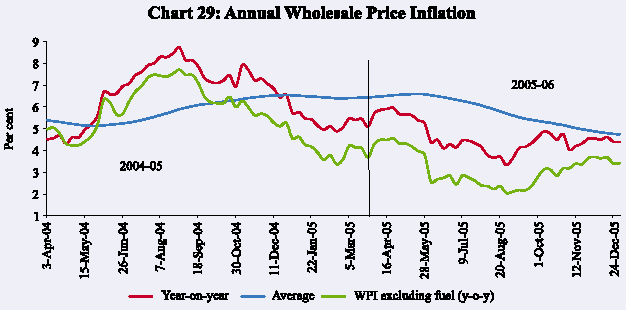
Domestic iron and steel prices eased somewhat during the third quarter of 2005-06 reflecting the recent trends in international steel prices. Prices had increased during the first quarter of 2005-06 but moderated during the second quarter as domestic companies announced cuts/rebates of about 10-12 per cent in prices of select products during June-July 2005 in line with easing trend in international prices and rising inventories. As international prices recovered on the back of production cuts by major global steel producers, domestic companies raised prices again in August 2005. Select product prices eased again thereafter on reports of oversupply in the international markets mainly due to substantial capacity build-up in China. On the whole, iron and steel prices have
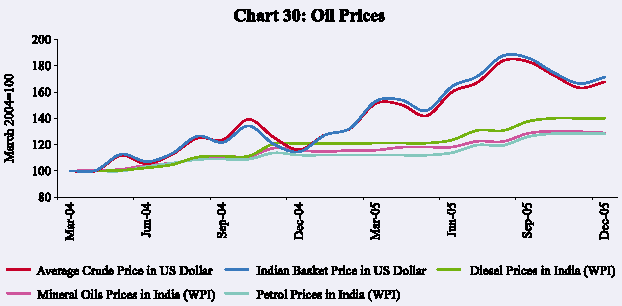
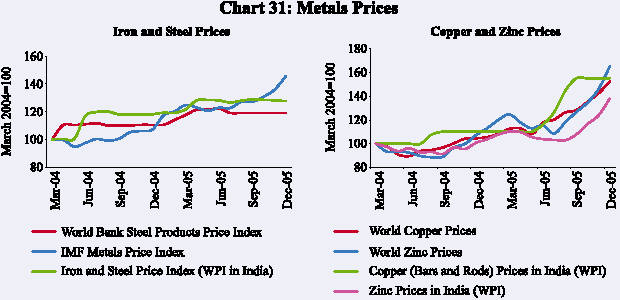
increased by 4.4 per cent during the current financial year up to December 31, 2005 as compared with an increase of 18.7 per cent during the corresponding period of last year. In contrast, prices of non-ferrous metals - copper and zinc -rose sharply. During the fiscal year so far (up to December 31, 2005), prices of copper and zinc have increased by 40.8 per cent and 31.3 per cent, respectively (Chart 31).
Vegetables prices remained high for most part of the third quarter of 2005-06 deviating from the seasonal pattern due to damages to the standing crops from excessive rains/floods in various parts of the country. However, there are signs of moderation since early December 2005. Improved crop prospects are likely to have a soothing effect on food prices in the coming months. Domestic sugar prices continued to remain firm in the third quarter in line with international trends. Although sugarcane output in the country is estimated to be higher during 2005-06, depleting stocks coupled with higher export prices are expected to keep domestic prices firm. Raw cotton prices - which remained flat during the first half of the year - increased during November-December 2005 in tandem with international trends. On the whole, raw cotton prices have increased by 8.4 per cent during the fiscal year so far up to December 31, 2005. Cotton textiles prices, however, declined (Chart 32).
Oilseeds prices have moderated since November 2005 on improved crop prospects. The prices had hardened somewhat during the first half of 2005-06 reflecting last year’s shortfall in domestic kharif production and worries about a poor ensuing crop due to the unsatisfactory progress of the South-West monsoon. Edible oil prices also declined (Chart 33).
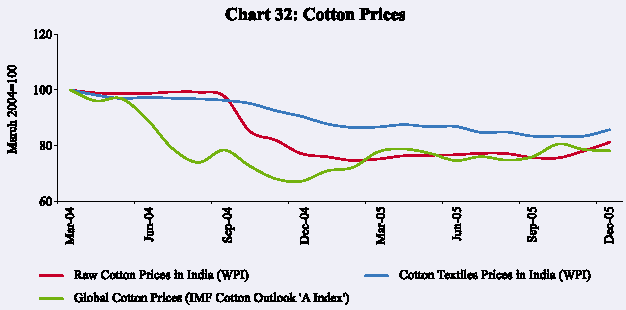
In brief, domestic WPI inflation during 2005-06 so far has been dominated by a few items led by mineral oil prices, which alone have contributed over a third of the headline inflation. Accordingly, the contribution of the fuel group to y-o-y overall WPI inflation as on December 31, 2005 was higher at 39.3 per cent (37.1 per cent a year ago). Manufactured products group’s contribution decelerated to 36.1 per cent (55.0 per cent) as prices of edible oils, oil cakes and textiles declined. On the other hand, primary articles’ contribution to the overall inflation increased mainly due to aberrations in the seasonal behaviour of vegetables prices (Chart 34).
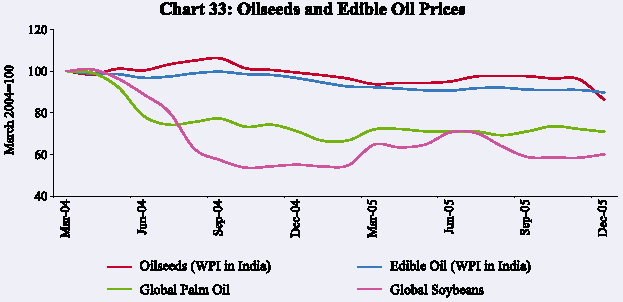
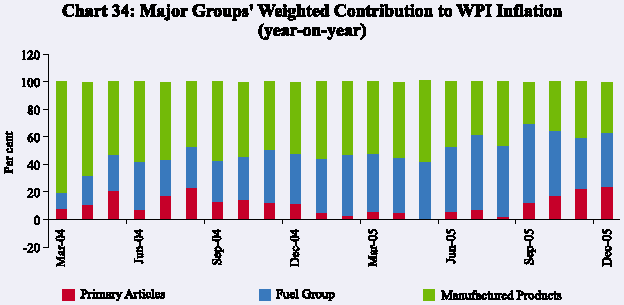
Consumer Price Inflation
Consumer price inflation (measured by the CPI for Industrial Workers) during November 2005 increased to 5.3 per cent from 4.2 per cent in March 2005. Other measures of consumer price inflation also edged up in November 2005 reflecting higher food and fuel prices (Table 28).
Disaggregated information on CPI (Industrial Workers) available up to October 2005 shows firming up of food prices from the March 2005 level. Services inflation - proxied by the miscellaneous group in the CPI-IW - edged up reflecting increase in the prices of education and recreation. On the other hand, increase in the housing index - which includes rent paid for rented, self-owned and rent free houses - in the CPI-IW basket decelerated from its March 2005 level (Table 29).
|
Table 28: Consumer Price Inflation (CPI) in India (year-on-year) |
||||||||
|
(Per cent) |
||||||||
|
Inflation Measure |
March |
March |
November |
March |
June |
September |
October |
November |
|
2003 |
2004 |
2004 |
2005 |
2005 |
2005 |
2005 |
2005 |
|
|
1 |
2 |
3 |
4 |
5 |
6 |
7 |
8 |
9 |
|
CPI-IW |
4.1 |
3.5 |
4.2 |
4.2 |
3.3 |
3.6 |
4.2 |
5.3 |
|
CPI- UNME |
3.8 |
3.4 |
4.0 |
4.0 |
3.9 |
4.8 |
4.5 |
5.5 |
|
CPI-AL |
4.9 |
2.5 |
3.3 |
2.4 |
2.7 |
3.2 |
3.2 |
4.7 |
|
CPI-RL |
4.8 |
2.5 |
3.3 |
2.4 |
2.7 |
3.2 |
3.2 |
4.6 |
|
Memo: |
||||||||
|
WPI Inflation (end period) |
6.5 |
4.6 |
7.3 |
5.1 |
4.3 |
4.3 |
4.8 |
4.5 |
|
IW : Industrial Workers. UNME : Urban Non-Manual Employees. |
||||||||
|
Table 29: Consumer Price Inflation for Industrial Workers (year-on-year) |
|||||||||
|
(Per cent) |
|||||||||
|
Commodity |
March 2005 |
October 2004 |
October 2005 |
||||||
|
Weight |
Inflation |
WC |
Inflation |
WC |
Inflation |
WC |
|||
|
1 |
2 |
3 |
4 |
5 |
6 |
7 |
8 |
||
|
General Index |
100.0 |
4.2 |
100.0 |
4.6 |
100.0 |
4.2 |
100.0 |
||
|
1. |
Food Group |
57.0 |
1.6 |
21.7 |
3.4 |
42.1 |
4.1 |
54.4 |
|
|
i. |
Cereals and Products |
20.5 |
0.7 |
2.9 |
-0.2 |
-0.9 |
2.6 |
11.2 |
|
|
ii. |
Pulses and Products |
3.6 |
-2.0 |
-1.9 |
6.2 |
5.3 |
5.3 |
5.1 |
|
|
iii. |
Oils and Fats |
5.0 |
-7.1 |
-6.9 |
0.8 |
0.7 |
-4.8 |
-4.3 |
|
|
iv. |
Meat, Fish and Eggs |
4.3 |
5.0 |
6.3 |
6.9 |
7.5 |
6.4 |
7.8 |
|
|
v. |
Milk and Products |
6.5 |
1.7 |
2.5 |
3.1 |
3.9 |
1.7 |
2.3 |
|
|
vi. |
Condiments and Spices |
3.2 |
-9.0 |
-7.6 |
-4.6 |
-3.7 |
15.6 |
12.6 |
|
|
vii. |
Vegetables and Fruits |
5.7 |
6.5 |
8.2 |
12.9 |
17.6 |
3.4 |
5.5 |
|
|
viii. |
Other Foods |
8.3 |
7.8 |
17.7 |
6.0 |
12.2 |
5.8 |
13.2 |
|
|
2. |
Pan, Supari, Tobacco and Intoxicants |
3.2 |
2.1 |
2.1 |
3.0 |
2.7 |
1.8 |
1.7 |
|
|
3. |
Fuel and Light |
6.3 |
4.9 |
8.7 |
10.0 |
15.3 |
-5.5 |
-9.7 |
|
|
4. |
Housing |
8.7 |
20.4 |
50.0 |
11.7 |
25.6 |
11.7 |
30.0 |
|
|
5. |
Clothing, Bedding and Footwear |
8.5 |
2.3 |
3.3 |
2.7 |
3.3 |
2.6 |
3.5 |
|
|
6. |
Miscellaneous Group (Services) |
16.4 |
3.9 |
15.6 |
3.6 |
12.8 |
4.2 |
16.4 |
|
|
i. |
Medical Care |
2.6 |
4.4 |
3.2 |
5.4 |
3.5 |
2.7 |
1.9 |
|
|
ii. |
Education and Recreation |
3.1 |
5.1 |
3.4 |
3.8 |
2.3 |
6.9 |
4.6 |
|
|
iii. |
Transport and Communication |
2.7 |
6.8 |
5.0 |
3.2 |
2.2 |
6.9 |
5.1 |
|
|
iv. |
Personal Care and Effects |
3.3 |
3.2 |
2.5 |
4.1 |
2.9 |
2.6 |
2.0 |
|
|
v. |
Others |
4.7 |
1.7 |
1.8 |
1.7 |
1.6 |
2.9 |
3.0 |
|
|
WC: Weighted Contribution. |
|||||||||
Asset Prices
Equity and gold prices recorded sharp increases during the quarter ended December 2005. Buoyancy in equity markets continued on the back of corporate performance, continued liquidity support by FIIs and better prospects for economic activity (Chart 35). Corporate profitability remains strong and profits
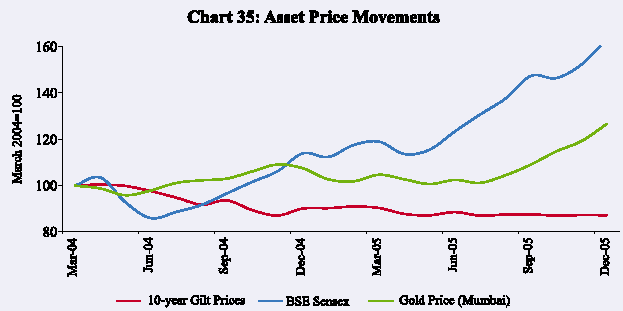
after tax have increased by 41.3 per cent during April-September 2005. Domestic gold prices remained firm in line with international trends. International gold prices have risen sharply since mid-2005 - crossing US $ 550 per ounce in mid-January 2006 - as investors preferred gold in an environment of higher headline inflation. Higher demand for gold was also influenced by renewed interest by hedge funds who switched to gold away from oil on the back of forecasts about some slowdown in global oil demand. Gilt prices have been largely range bound since May 2005 with intra-year movements influenced by trends in domestic inflation and liquidity conditions.
ಪೇಜ್ ಕೊನೆಯದಾಗಿ ಅಪ್ಡೇಟ್ ಆದ ದಿನಾಂಕ:

















